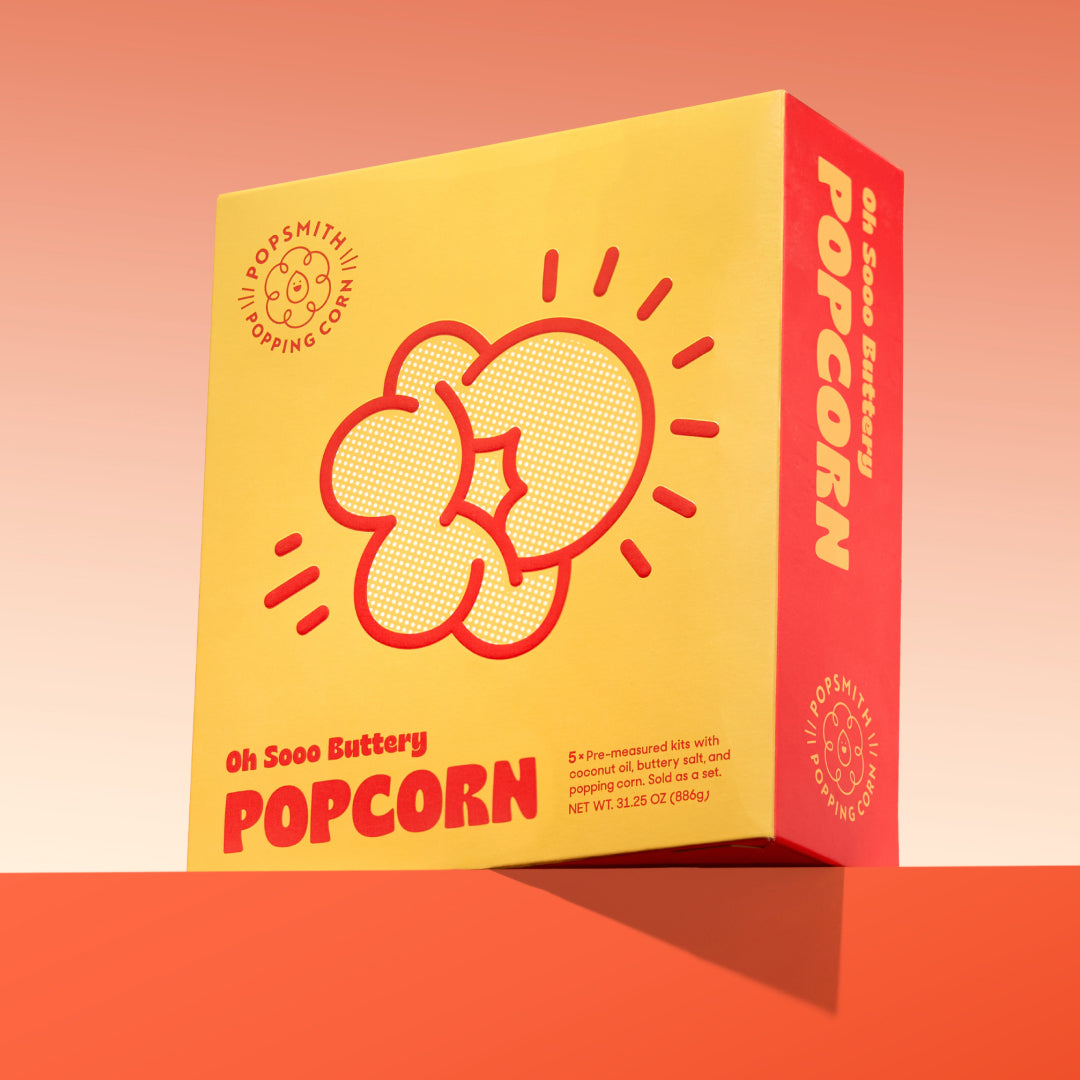While all corn might look similar on the stalk, popcorn kernels are fundamentally different from the sweet corn you eat off the cob or the field corn they use for animal feed.
Popcorn has a hard, moisture-sealed hull that allows pressure to build inside until the kernel explodes and transforms into your favorite snack. Regular field corn and sweet corn lack this structure, so they'll just burn if you try popping them.
Popcorn vs. Field Corn and Sweet Corn at a Glance
| Feature | Popcorn | Field Corn | Sweet Corn |
|---|---|---|---|
| Does it pop? | Yes ✓ | No ✗ | No ✗ |
| Moisture content | Very low (13–14%) | Medium (15–20%) | High (70%+) |
| Best for | Snacking | Animal feed, processing | Eating fresh off the cob |
| Taste when raw | Dry, hard, flavorless | Starchy, bland | Sweet, juicy |
| Harvest timing | Fully dried on stalk | When mature and dry | When immature and sweet |
Why Does Popcorn Pop But Regular Corn Doesn't?

Let's go deeper into what we just mentioned. The transformation from hard kernel to snack all boils down to three factors: hull strength, moisture content, and starch structure.
The Incredible Hull
Popcorn's hull, also known as its pericarp, is roughly thrice as hard and thick as other corn varieties. But thickness alone isn't what makes it special. The hull is also non-porous, meaning it creates an airtight seal around the interior of the kernel. It's basically like a miniature pressure cooker.
Regular field corn and sweet corn, in comparison, have softer and more porous hulls. Any moisture inside simply evaporates when you heat it, thanks to tiny openings in the hull. No pressure equals no popping.
The Moisture Sweet Spot
Trapped in every popcorn kernel is a tiny droplet of water — exactly 13-14% of the kernel's weight. That water turns into steam when you heat a kernel enough. And because the hull won't let the steam escape, pressure builds until the hull can't take it anymore and — boom — POPS.
Regular corn doesn't have these same properties. It either has too much moisture (sweet corn at 70%) or the wrong hull structure.
The Expanding Starch
Even if it were possible to seal regular corn in a pressure vessel and heat it, it still wouldn't pop like popcorn.
That's because popcorn has a special type of starch that becomes soft and gel-like at high temperatures. When the hull explodes and pressure lets loose, this gelatinized starch quickly expands and foams outward, then instantly cools and becomes what we all know as popcorn.
Why Do Some Kernels Not Pop?
Notice unpopped kernels (aka old maids) at the bottom of your bowl? These are the usual reasons why they don't pop:
- Moisture too low: The kernel dried out and can't create enough steam
- Hull damage: A tiny crack lets steam escape before pressure builds
- Uneven heating: The kernel didn't get hot enough to build pressure
This is why using coconut oil and a popcorn popper with a multi-clad metal bottom that evenly distributes heat is so important!
What Are the Different Types of Popcorn Kernels?
While all popcorn is Zea Mays Everta, there are several varieties with their own special characteristics affecting size, texture, and taste.
FUN FACT: Most popcorn plants are grown in the Midwest. The kernels we use specifically are from family-owned farms in Iowa and Missouri. This means you're guaranteed fresh, flavor-packed goodness with every handful of our stovetop popcorn.
Pearl Popcorn
This type of popcorn has large, round kernels with a distinctive dome shape. These kernels are slightly yellow and keep that hue even after they pop.
Pearl popcorn is incredibly durable and has a slightly thicker hull than rice popcorn — it can hold up under even the heaviest seasonings without getting soggy. It also expands 45 times its original size, creating big, fluffy popcorn for your movie night.
Rice Popcorn
Rice popcorn kernels are pointed and elongated, just like grains of rice (hence the name). These kernels are slightly smaller than pearl popcorn — growing around 40 times their original size — and tend to be a lighter yellow color.
When rice popcorn pops, it creates tender bright white pieces with a delicate texture. And because it's lighter than pearl popcorn, it's best for recipes with lighter seasonings, like a pinch of salt.
Different Popcorn Colors
Popcorn kernels come in a rainbow of colors, including blue, red, and purple, and even pink. These colorful popcorn kernels are usually heirloom or specialty varieties that have been grown for generations.
While the color of the popcorn doesn't affect texture, it does influence its taste. Colored popcorn tends to have a more pronounced corn flavor with slightly earthy or nutty tones. White and yellow popcorn are more neutral, making them perfect for bold seasonings.
GOOD TO KNOW: Most kernels pop white or off-white regardless of their color. That's because the pigments are in the hull, which shatters during popping.
What Are the Different Types of Corn Plants?

Regular corn is also incredibly diverse, with thousands of varieties grown worldwide. But most fall into the following categories — sweet corn, field corn, and flint corn:
Sweet Corn
Sweet corn is what you see at farmers markets and roadside stands every summer. This is the corn you eat fresh off the cob, slathered in butter.
It's grown for high sugar content (up to 20% more than field corn), which makes it delicious but also means it should be harvested while it's immature and full of moisture (about 70% water content).
Field Corn
Field corn (also called dent corn) is the most widely grown corn in the United States. It's likely what comes to mind when you think of corn — tall green stalks and bright yellow cobs. The "dent" name comes from the dimple that forms on its kernels as they dry.
Field corn is starchy, not sweet. It's not meant for human consumption, at least in its whole kernel form. Instead, it's processed into:
- Animal feed
- Corn syrup and sweeteners
- Ethanol for biofuel
- Industrial products
Flint Corn
Also known as Indian corn, flint corn is the decorative multicolored corn you see in fall displays. This corn variety has even tougher hulls than field corn but can't pop since the hull structure and the internal starch are different from popcorn.
Native Americans grew flint corn often because it stored well and could be turned into cornmeal. Its gorgeous colors come from natural anthocyanin pigments, which are the same compounds found in red wine and berries.
Learn More Popcorn Fun Facts with Popsmith
Popcorn vs. Regular Corn: A Quick Comparison
Corn vs Popcorn FAQs
Can regular corn pop like popcorn?
Nope, regular corn doesn’t pop like popcorn kernels. Popcorn kernels have a lower moisture content than regular corn. The endosperm on regular corn will not pop under pressure as it does on popcorn. You can try popping it but you’ll likely just end up with a bowl full of burnt corn kernels.
Is popcorn considered a vegetable?
Despite what you might think, corn isn't actually a vegetable. It's considered a whole grain instead. Every type of corn is a grain; however, many grains are considered to be fruit.
Do you dry popcorn before or after you harvest it?
Popcorn kernels need to be dried on the cob before harvest. One way to check whether the popcorn cob is ready for harvesting is by checking the husk. If the husk is dry and all the kernels in the corn are dry, it’s ready. The drying process can take a week or longer, depending on the weather.
Are corn and popcorn healthy?
Corn and popcorn both provide some health benefits, but they aren’t always healthy.
Field corn is highly processed before it’s ready to use. This makes it lean toward the unhealthy side, especially since it’s often turned into sugary syrup. Sweet corn, though, can be a great source of antioxidants, vitamins, and minerals.
Popcorn, on the other hand, isn’t inherently unhealthy. It's the seasoning and oil people add that can take away the beneficial carbohydrates and decrease the nutritional value.







